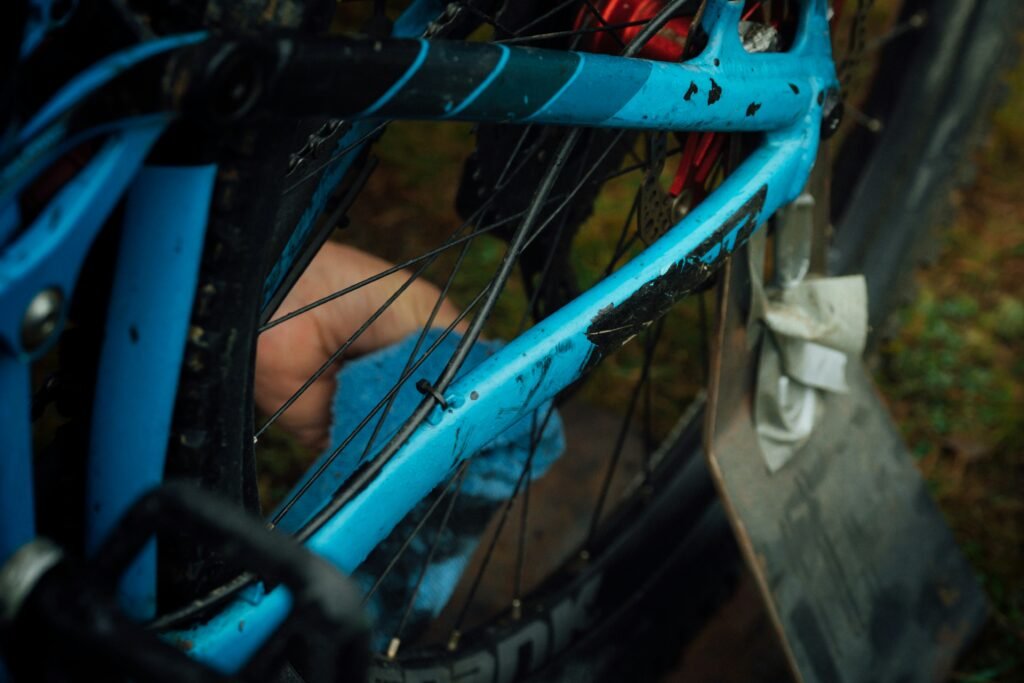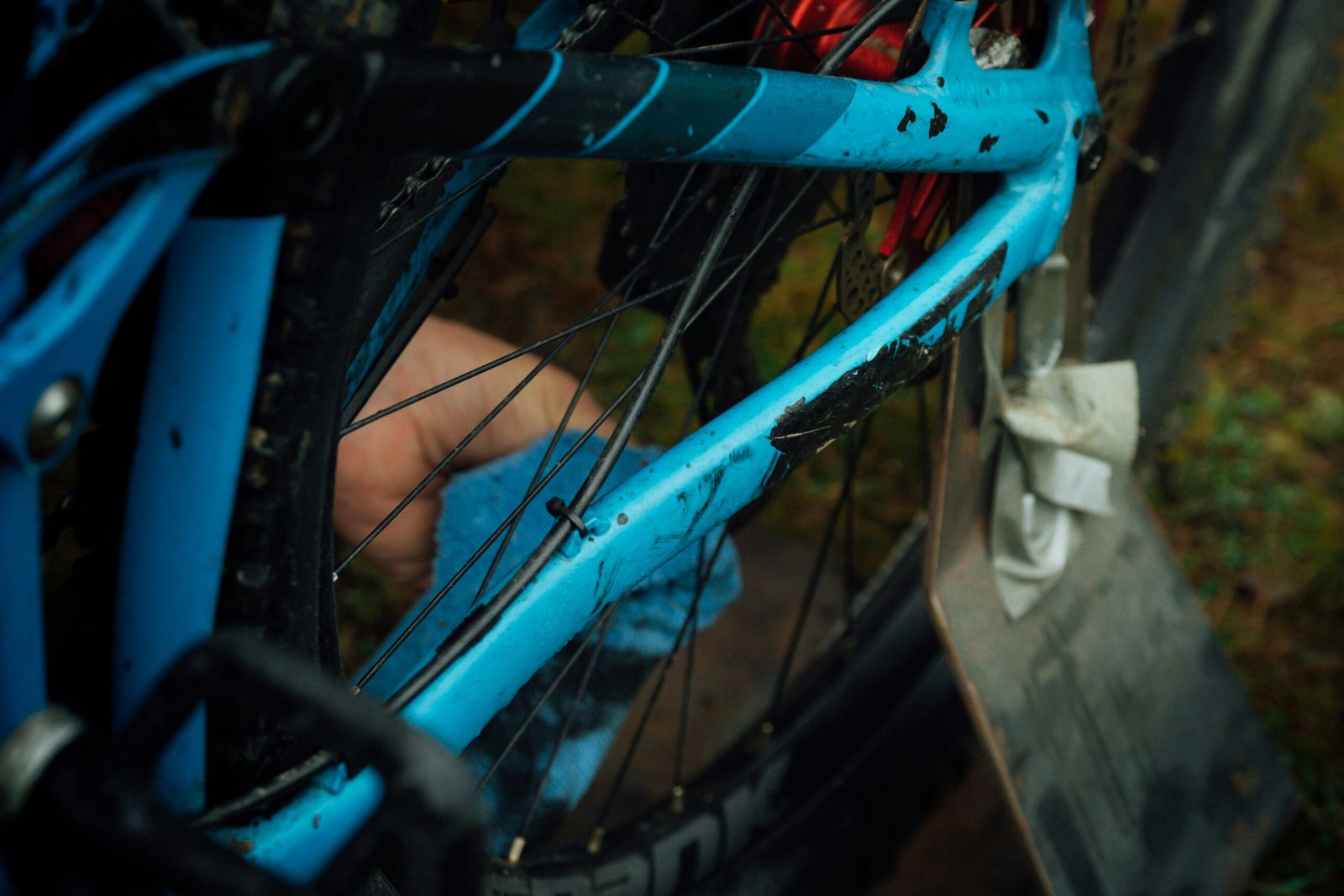Have you recently taken up off-road biking and discovered that keeping your bike clean is an essential aspect of maintenance? Well, fear not, as we’ve got you covered with these essential cleaning tips for off-road bikes. With these easy-to-follow tips, you’ll be able to master the art of cleaning your off-road bike in no time, ensuring that it stays in top condition for all your adventurous rides. From tackling dirt and mud to properly lubricating the chain, we’ll guide you through the necessary steps to keep your bike looking and performing its best. So, grab your cleaning supplies and get ready to transform your dirty bike into a sparkling, well-maintained machine!
Gather the necessary tools
To effectively clean your off-road bike, you’ll need a few essential tools. Make sure you have a high-pressure hose, which will help in rinsing off the dirt and grime. Additionally, a bucket, sponge or brush, degreaser, chain cleaner, and chain lubricant are necessary for a thorough cleaning. Lastly, having a bike stand or rack will make the process of cleaning much easier and more convenient.
Preparation
Before you dive into cleaning your off-road bike, it’s important to set up the right environment and make necessary preparations. Find an appropriate cleaning area that is well-ventilated and has easy access to water. Remove any accessories such as lights, saddlebags, or bottle cages to ensure a thorough cleaning. Setting up a bike stand or rack will provide stability and make the cleaning process more comfortable. Finally, prepare the cleaning solution by mixing water and a mild detergent or bike-specific cleaner in the bucket.

This image is property of images.unsplash.com.
Basic cleaning
Now that you’re ready to start cleaning, follow these steps for a basic cleaning of your off-road bike:
- Rinse the bike with a high-pressure hose to remove any loose dirt and debris. Start from top to bottom, ensuring that you cover all areas of the bike.
- Use a sponge or brush to scrub off any remaining dirt and mud. Be gentle yet thorough, paying attention to hard-to-reach areas.
- Clean the frame and fork using the sponge or brush and the cleaning solution prepared earlier. Focus on areas that are prone to accumulating dirt and grime.
- Wash the wheels and tires by scrubbing them with the sponge or brush and the cleaning solution. Pay close attention to the spokes, rim, and tread of the tires.
- Clean the drivetrain thoroughly using a degreaser. Apply the degreaser to the chain, cassette, and chainrings, and use the brush or sponge to scrub off any built-up grease and dirt.
- Rinse off the degreaser using the high-pressure hose, making sure to remove any residue.
- Dry the bike thoroughly using a clean towel or cloth. It’s important to remove all moisture to prevent rust and corrosion.
Cleaning the drivetrain
The drivetrain is one of the most crucial components of your off-road bike, so it requires special attention. Follow these steps to clean the drivetrain effectively:
- Apply a degreaser specifically designed for bike drivetrains to the chain, cassette, and chainrings. Make sure to follow the instructions provided by the manufacturer.
- Use a brush or sponge to scrub the chain, cassette, and chainrings, removing any built-up dirt and grime. Pay attention to each individual component and ensure a thorough cleaning.
- Rinse off the degreaser using the high-pressure hose, making sure to remove any residue. Be careful not to spray directly into sensitive parts, such as bearings.
- Dry the drivetrain thoroughly using a clean towel or cloth. It’s crucial to remove all moisture to prevent rust and maintain optimal performance.
- Lastly, apply a suitable chain lubricant to the chain, making sure to cover each link. Follow the manufacturer’s instructions for the proper application and quantity.

This image is property of images.unsplash.com.
Deep cleaning
For a more thorough cleaning of your off-road bike, consider performing a deep cleaning. This can help maintain the longevity and performance of various components. Follow these steps for a deep cleaning:
- Start by removing the wheels. This will allow you to access and clean the wheel hubs and spokes more effectively.
- Clean the wheel hubs and spokes using a sponge or brush and the cleaning solution. Pay attention to any dirt or debris that may have accumulated in these areas.
- While the wheels are removed, take the opportunity to inspect the brake pads and rotors for wear and tear. Replace them if necessary, or clean them using an appropriate brake cleaner.
- If your bike has suspension components, clean and lubricate them according to the manufacturer’s instructions. This will help maintain their functionality and prevent any damage caused by dirt or debris.
- Check and adjust the headset, ensuring that it is tight and properly aligned. Any looseness or misalignment can affect the bike’s handling and safety.
- Inspect and clean the bottom bracket, which connects the crankset to the frame. Remove any dirt or debris, and apply grease if necessary to ensure smooth operation.
Cleaning the chain
The chain is a vital component of your off-road bike, responsible for transferring power from your pedaling to the wheels. Follow these steps to effectively clean the chain:
- Use a chain cleaner to remove any built-up dirt and grime. Apply the cleaner to the chain, and rotate the pedals backward to allow the cleaner to penetrate the chain links.
- Use a brush, specifically designed for cleaning chains, to scrub the chain thoroughly. Move the brush up and down the chain to ensure all areas are cleaned.
- Rinse off the chain cleaner using the high-pressure hose, making sure to remove any residue. Be cautious not to spray directly into sensitive parts or bearings.
- Dry the chain completely using a clean towel or cloth. It’s crucial to remove all moisture to prevent rust and to maintain optimal performance.
- Apply a suitable chain lubricant, following the manufacturer’s instructions. Make sure to cover each link, allowing the lubricant to penetrate the chain for smooth and efficient operation.

This image is property of images.unsplash.com.
Inspecting and maintaining
Regular inspection and maintenance are important to ensure your off-road bike is in top condition. Here are some key areas to check and maintain:
- Check the tire pressure regularly and inflate them as needed. Proper tire pressure enhances performance and helps prevent flats.
- Inspect the tires for any signs of damage, such as cuts, tears, or excessive wear. Replace the tires if necessary to maintain optimal traction and safety.
- Examine the brakes and brake pads for wear. Replace the brake pads if they are worn down to ensure effective braking performance.
- Check the suspension system for any signs of leaks or damage. If you notice any issues, consult a professional bike mechanic to address the problem and prevent further damage.
- Inspect the frame for cracks or dents, paying close attention to high-stress areas. Any structural damage should be addressed promptly to avoid compromising the bike’s integrity and safety.
- Check the gears and derailleur alignment to ensure smooth shifting. Make any necessary adjustments using the appropriate tools or consult a professional bike mechanic for assistance.
- Tighten any loose bolts or screws throughout the bike, including the handlebars, saddle, and other components. Loose parts can affect the bike’s performance and compromise safety.
Storage and protection
Proper storage and protection are essential to maintain your off-road bike’s condition, especially during periods of non-use or when exposed to harsh conditions. Follow these guidelines:
- Before storing the bike, clean and dry it thoroughly to remove any dirt and moisture. This will help prevent rust and corrosion during storage.
- If storing the bike outdoors, cover it with a waterproof bike cover or keep it in a protected area such as a garage or shed. This will shield it from the elements and minimize damage.
- Use a suitable lubricant, such as a rust protectant or bike-specific corrosion inhibitor, to protect metal parts from corrosion during storage.
- If your bike has a removable battery, remove it before storage to prevent any potential damage or discharge.
Safety precautions
When cleaning your off-road bike, it’s important to prioritize safety. Follow these safety precautions:
- Wear gloves and protective eyewear to protect your hands and eyes from any cleaning chemicals or debris.
- Use caution when handling cleaning chemicals, following the instructions provided by the manufacturer. Avoid contact with skin or eyes and ensure proper ventilation in the cleaning area.
- Keep your fingers clear of moving parts such as the chain, gears, and wheels to prevent any accidents or injuries.
- Ensure the bike is stable and secure by using a bike stand or rack. This will prevent any mishaps or accidents while you clean and maintain the bike.
Frequently asked questions (FAQs)
Here are answers to some common questions about cleaning off-road bikes:
How often should I clean my off-road bike?
The frequency of cleaning your off-road bike depends on various factors, such as riding conditions and frequency. As a general rule, it’s recommended to clean your bike after every muddy or dirty ride. Regular maintenance and cleaning will help prolong the lifespan of your bike and its components.
Can I use a pressure washer to clean my bike?
While a high-pressure hose may be used to rinse off the dirt, using a pressure washer is not recommended for cleaning off-road bikes. The high-pressure water can force dirt and debris into sensitive areas, potentially causing damage to bearings, seals, and other components. Stick to a high-pressure hose and gentle scrubbing for a safe and effective cleaning process.
What type of lubricant should I use for the chain?
It’s important to use a lubricant specifically designed for bike chains. There are various types of chain lubricants available, including dry, wet, and ceramic lubes. The choice depends on the riding conditions and personal preference. Dry lubes are suitable for dry and dusty conditions, while wet lubes are designed for wet and muddy conditions. Ceramic lubes offer increased durability and performance but may be more expensive.
How do I clean and maintain the suspension system?
Cleaning and maintaining the suspension system require specific knowledge and tools. For routine maintenance, you can wipe down the stanchions with a clean cloth after each ride to remove any dirt or debris. However, if you notice any leaks or issues with the suspension, it’s best to consult a professional bike mechanic to address the problem and perform necessary maintenance.
How can I protect my bike from rust?
To protect your off-road bike from rust, ensure it is properly cleaned and dried after each ride. Applying a suitable rust protectant or corrosion inhibitor to metal parts can also help prevent rust formation. Additionally, storing the bike in a dry and protected area will minimize exposure to moisture and prevent rust from developing.
Can I use household cleaning products on my bike?
Household cleaning products, such as dish soap or all-purpose cleaners, may contain chemicals that can be harsh and damaging to the bike’s components. It’s recommended to use bike-specific cleaning products that are designed to effectively clean without causing harm to the bike. These products are formulated to remove dirt and grime while being gentle on materials like carbon fiber, aluminum, and steel.
What should I do if I notice any damage during the cleaning process?
If you notice any damage while cleaning your off-road bike, it’s best to consult a professional bike mechanic for a thorough inspection and necessary repairs. They have the expertise to assess the extent of the damage and recommend appropriate solutions. It’s important not to ignore any damages, as they can compromise both the performance and safety of your bike.
